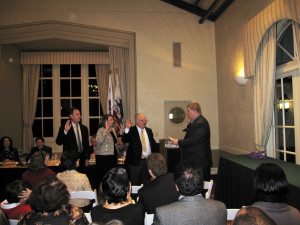John Tulloch
Piedmont City Clerk
Re: Piedmont Pension Bonds
Mr. Tulloch
As you may recall, I came by your office a week ago Friday and you kindly provided me copies of the above captioned February 4th Pension Bond Ballot Measure. While I am not a resident of Piedmont I am nevertheless acutely interested in the matter. I am a native of Oakland and have watched Oakland’s Pension Bond debt on the now closed (pre-PERS) Police and Fire Retirement System (PFRS) grow to an unsustainable amount. All the while the present City PERS, Police and Fire and the Miscellaneous employees systems continue to grow by substantial amounts.
Oakland, along with its Bond Counsel, Orrick, Herrington and Sutcliffe LLP, brags that it pioneered the “pension bond” back in 1985. Unfortunately, the City’s Pension Bond debt is now close to one billion dollars (for PFRS alone) and having lost considerable amounts in investments. An October 2010 City Auditor’s special report (Courtney Ruby, see City WEB site, cityauditor@oaklandnet.com) indicates, through its bond issues, the City lost, since 1998, approximately $250 million dollars.
While the City of Piedmont is considerably smaller its Bond Measure still represents millions of dollars in taxpayers money. A review of the Measure’s language and background material (the May 29, 2013 BAFP Committee Report) it is clear that sometime prior to 2003 the City Council over-extended the pension benefits to its employees, driving the cost sky high and beyond a sustainable amount. However, it is not my intent to criticize the Council for what it did back then but to raise questions and legal concerns regarding the present (Feb. 4th) Pension Bond Ballot Measure and the obvious need for full public disclosure.
1.) The Measure indicates that by Section 4.14 of the City Charter that only a 50 % affirmative vote is required for passage. Although the Charter language stipulates that the question submitted to the electors is to be in full compliance with the provisions of the State Constitution and other State laws, it appears to run afoul of the State Constitution and the debt limitations. The 1879 Constitution (although dating back to 1850 – see People v. Johnson (1856) 6 Cal. 499; Nougues v. Douglass (1857) 7 Cal. 65) Article XVI, Section 18, in pertinent part, prohibits cities (including charter cities) from entering into indebtedness that in any year exceeds the income and revenue provided for such year unless the city first obtains two-thirds (2/3) voter approval for the obligation. (See Garrett v. Swanton, 216 Cal. 220, at p. 226).There are three notable exceptions to this requirement: (1) The Offner- Dean exception; (2) The Special fund doctrine; and (3) the “obligations imposed by law” exception. Disregarding the non-applicable first two exceptions, the City, by its Ordinance No. 711 N.S., paragraph (e), is claiming the “obligation imposed by law” exception. However, recent appellate court cases have determined that the, “obligation imposed by law” exception is not applicable to Pension Bonds. In State ex rel. Pension Obligation Bond Commission v. All Persons Interested (2007) 152 Cal. App. 4th 1386, the court held, the exception does not apply to the State’s obligation to fund PERS because the obligation is one the Legislature voluntary imposed upon itself.Please Note, the above case concerns Constitutional Article XVI Section 1, rather than Section 18. Where Section 1, deals with the State and Section 18 deals with Cities, Counties, School districts, etc., the language is practically identical. While Section 18 has not yet been the direct subject of a Pension Bond legal challenge the application is the same. Some attorneys have argued that the PERS “side fund” creates a difference in claiming that the side fund is an obligation imposed by law. Their reasoning is fatally flawed in that all PERS obligations are strictly voluntary, usually the result of bargaining unit negotiations or direct City Council legislative action. See County of Orange v. Association of Orange County Deputy Sheriff’s (2011) 192 Cal. App. 4th 21, and cases cited therein.
2.) The Bond enacting Ordinance, No. 711 N.S., at paragraph “e”, claims that the “Side Fund Obligation” are “debt obligations” of the city imposed by law. It appears the City is incorrect in both instances. The Side Fund is neither a “debt obligation” nor is it “imposed by law”. The Side Fund is the “Unfunded Accrued Actuarial Liability” (UAAL) or simply the Unfunded Liability (UL). (See above, State ex rel. Pension Obligation Bonds Commission v. All Persons Interested, validation case and County of Orange v. Association of Orange County Deputy Sheriff). Both cases clearly hold that the UL and or the UAAL are not, in the true sense of the term, a debt obligation nor an obligation imposed by law.
3.) Also, the Ordinance, at paragraph (f.) indicates that the City is authorized to issue “refunding bonds” or “incur indebtedness” for the purpose of refunding any evidence of indebtedness under Government Code, Section 53570 or its Charter, Section 4.14. It does not appear that this section provides the necessary authority. Sections 53570-53572 deal with “revenue bonds” and the refunding of revenue bonds while the City’s proposal is to issue “new” general obligation bonds for the specific purpose of funding the PERS side fund (the pension funds’ unfunded liability [UL]). The “side funds” are not an existing debt under the law subject to refinancing – they are no more than regular contract obligations entered into voluntary by the parties. Further, the PERS laws (Gov. Code, secs. 20840 et seq., risk pools) creating the side funds, does not create a financial obligation “imposed by law”. It is simply an actuarial assumption determined by PERS in order to finance the parties agreed to employee pension benefits. Again, see cases cited above.
4.) Section 4 of the Ordinance is clearly a “Blank Check”. “…to do any and all things that they deem necessary or advisable…” Should the people of Piedmont approve this Bond Measure they will completely loose whatever opportunity they may have had to oversee or approve any future Bond deals relating to the pensions. It is an “unlimited” blank check – it couldn’t be any worse.
5.) Also, the structure of the Measure and the enabling Ordinance beg a haunting question – should the voters approve the Measure does the voter approval then not authorize the City to collect a property tax to service the bond debt in excess of the limitations imposed by Proposition 13? (See Valentine v. City of Oakland (1983) 148 Cal. App. 3d 139; Bandt v. Board of Retirement, (2006) 136 Cal. App. 4th 140; Carman v. Alvord, (1982) 31 Cal. 3d 318; and Howard Jarvis Taxpayers Association v. County of Orange [City of Hunting Beach] (2003) 110 Cal. App. 4th 1375.
6.) Additionally, as the Ordinance indicates, at paragraph “d”, speaking to the Side Fund, and showing amounts of $2,311,901 and $5,532, 124) it notes: “This amount changes from time to time based on actuarial determinations prepared by PERS.” This of course begs another haunting question, considering “the amounts change from time to time”, and that the amounts (Side Fund, UAAL) are merely “projected” amounts depending on investment returns and numerous other factors (see Orange County Sheriffs) then exactly what amount does the City intend to bond. And, if the amount increases in the near future (which it usually does) will that not require the need to sell additional bonds. How can you sell bonds and expect to save money, to cover an amount that is ever changing?
7.) The Council Agenda Report of October 7, 2013 features a comparative earnings and payment sheet on projected debt and bond payments, (BAFP Report). What the sheet does not show nor indicate is by far the most crucial to making a comparison – what kind of bonds and for what term. There are as many different bond issue out there as there are cars for sale on Broadway. There are the short term, 12 month, low interest bonds on one end of the scale and then the notorious Capital Appreciation Bonds (zero coupon) (CAB) on the other end. CABs are no payments, (interest or principal) for as long as 40 years costing as much as 15 to 20 times the original amount. A $2 million dollar bond can end up costing $40 million. The Report completely ignores any aspect of the crucial difference the term period makes – the interest rate is only part of the calculation. The differences can be huge.Many of the Pension Bond deals to cover Side Funds are a mixture of different types and terms, including CABs. Most are quickly refinanced costing the tax payer yet more money. Or extended for longer periods in order to lower payments to free up the City’s General Fund for other uses, again costing more and more money.
8.) The last issue. As was pointed out in the BAFP Committee Report of June 3 (p.19) and recently the subject of a letter to the Montclarion by Rick Schiller. The critical point, without a contract change of the employee payment “cap” the City’s scheme to bond the Side Fund will save the employees a substantial amount, but will actually cost the City more money. Considering there is no incentive for the employees to change the cap (costing them more money), what sense does this whole proposal make?
David E. Mix
 Paul Benoit will assume the duties of City Administrator on March 1. He attended the meeting to meet the new Council members and introduce himself to the gathered Piedmonters.
Paul Benoit will assume the duties of City Administrator on March 1. He attended the meeting to meet the new Council members and introduce himself to the gathered Piedmonters.


